Beavers Are Making a Comeback
And not just on the tributary of Beaver Run
 In the fall of 2012, I got a surprising email from a visitor to Welkinweir asking: “Do you have beavers in your ponds?” My initial response was “no way!” Although Welkinweir is surrounded by protected lands that make it feel remote, I thought beavers aren’t likely to be found in the suburbs where we are.
In the fall of 2012, I got a surprising email from a visitor to Welkinweir asking: “Do you have beavers in your ponds?” My initial response was “no way!” Although Welkinweir is surrounded by protected lands that make it feel remote, I thought beavers aren’t likely to be found in the suburbs where we are.
After all, beavers, with their highly desirable pelts, were extirpated from Pennsylvania (had become locally extinct here) by the beginning of the 20th century. In its heyday, felted beaver fur was prized because it made the best hats, with its tiny barbs on the soft underfur ensuring the fur remained matted when felted, so hats held their shape, lasted longer and were water resistant.
But with a bit of research I found that in the first couple of decades of the 1900s, the Pennsylvania Game Commission released beavers in remote areas of the Commonwealth. Now beavers are abundant throughout Pennsylvania. Including some at Welkinweir.
Beaver Facts
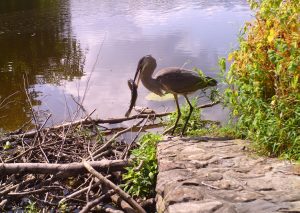
Beavers are the world’s second-largest rodent, with the North American and Eurasian beavers being quite similar. (FYI: the South American capybara is the largest living rodent.) Members of the rodent family (from the Latin rodere, meaning to gnaw) also include squirrels, mice, prairie dogs, guinea pigs and hamsters.
Rodents are characterized by a single pair of continuously growing incisors in the upper and lower jaws. Their constant chewing keeps the incisors sharp and trim. Beavers can weigh up to 60 pounds, grow to 40 inches long and have a 10-inch broad, flat tail used for fat storage and that’s slapped on water to warn of danger.
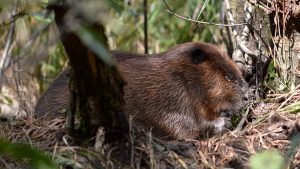
Active primarily at night, these nocturnal herbivores eat only woody plants like alder, birch, willow and cherry and herbaceous plants like water lilies and cattails, rather than fish, as sometimes thought. Adaptations — including webbed hind feet, thick fur, waterproof coat and a second eyelid that acts like goggles — enable beavers to spend most of their time in water. Their water habitat also provides protection from predators, given beavers are clumsy on dry land.
Beavers at Welkinweir
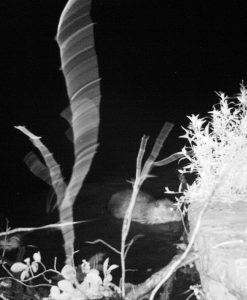
What our visitor had noticed around the ponds was the telltale signs of a feeding beaver: downed trees, gnawed stumps that were pointy on the ends. It was a thrilling discovery! Interestingly these ponds were constructed in the 1930s with a series of dams on a tributary to Beaver Run (yes, really).
The first beaver discovered here was a young “subadult” who left the family colony to establish new territory at Welkinweir. The following spring, he found a mate (beavers mate for life), constructed a large lodge of sticks and mud on the pond bank, and soon young beaver babies, called “kits,” were swimming in the pond. With many of their favorite food plants in and around the pond providing a year-round source of food to a growing beaver family, the beavers were well on their way to changing the look of our riparian landscape.
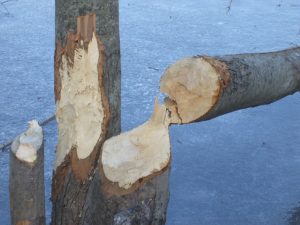
Beaver families, known as colonies, generally consist of two adults, the current year’s young, as well as the young from the previous one to two years. The oldest siblings leave the family to establish their own colony before the newest kits are born. As the beaver population grows, so do the number of beavers looking for their own territory. New colonies are limited by food and habitat availability.
These young adult beavers follow the region’s waterways and green corridors from Welkinweir, traveling down Beaver Run, on to French Creek, where there are signs of beaver activity along the creek into Phoenixville. Eventually they arrive at the Schuylkill River, as evidenced by beaver activity noted in Fairmount Park.
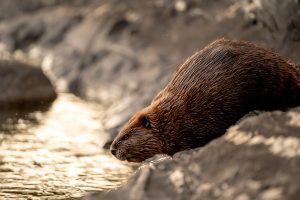 Return of the beavers is not all good news, though. Their spread into human-populated areas causes concerns and conflicts. For example, beavers take down trees for food, building lodges and damming waterways, which can cause flooding on property or in transportation corridors.
Return of the beavers is not all good news, though. Their spread into human-populated areas causes concerns and conflicts. For example, beavers take down trees for food, building lodges and damming waterways, which can cause flooding on property or in transportation corridors.
For Welkinweir, the many benefits of beavers outweigh the downsides. Our beavers offer great educational opportunities as visitors view the evidence of their work, and everyone gets a kick out of hearing the tail slap! Plus, we’ve learned how to protect trees we don’t want beavers to bother and have tools that enable easier cleanup of their dam building.
Ecological Benefits
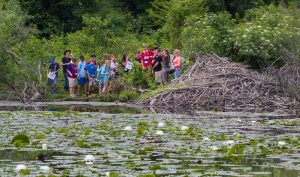
Beavers are considered a keystone species: one that has a disproportionately large effect on its natural environment relative to its abundance. Predators, like wolves, can also be keystone species by preventing any one species from becoming dominant.
Through their engineering activity, beavers create, modify and maintain habitat and ecosystems through their dam building. This valuable activity has a large impact on biodiversity by providing habitat for many insect, bird, amphibian, mammal and fish species. Beaver dams can naturally restore healthy streams and watersheds, improve water quality, store sediments, filter out nutrients and other pollutants, and slow water, leading to less erosion during storms. The water exiting a beaver dam is often cooler, which is beneficial for cool water fish like trout and salmon, and the openness of the design of the dam allows for fish passage.
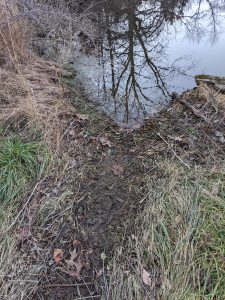
In the western U.S., where drought has adversely affected rivers and created conflicts between users of the rivers, many conservation organizations consider beavers “restoration contractors,” improving aquatic and river systems for far less money than traditional engineered solutions. Where beavers have been successfully reestablished, the improved habitat has enhanced salmon spawning and rearing and has multiple benefits in countering climate change effects.
Here in the East, the benefits of beaver activity to reduce runoff sediments, flooding and erosion are being noticed, and many more groups are finding ways to incorporate beavers into their restoration work. At the 2020 inaugural BeaverCON — a conference sharing the latest research and best management of “nature’s engineer,” the North American beaver — held near Baltimore, Maryland, the theme that emerged was: “We humans need a major re-education on the place of beavers in our landscape … western society needs more beaver believers … to rethink the path towards healthy watersheds.”
We at Welkinweir are beaver believers.
Welkinweir is a 224-acre arboretum and nature preserve, where history, horticulture and habitat meet. Located in East Nantmeal Township, 1368 Prizer Rd., Pottstown, Welkinweir is free and open Monday to Friday, 9 a.m. to 4:30 p.m. 610-469-7543; Welkinweir.org.
